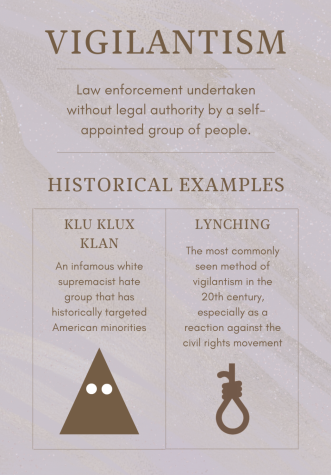
Check out his journalism website here: LINK


October 26, 2022
While Spider-Man can do whatever a spider can, everyday law-abiding citizens don’t have the luxury of being able to solve all their problems by simply putting on a mask and fighting criminals.

Consumers are drawn to vigilante movies as they allow people to escape their own problems by offering to immerse viewers in a simpler fantasy world.
However, outside of cinema, vigilantism is most often a result of frustration and anger at an imperfect society. As a result, when the wrong person is given enough motivation, disaster can occur.
“I think [vigilantes] are fed up. I believe that they see a broken criminal justice and judicial system. For people to choose vigilantism, they do so because they see something lacking in the system we already have in place,” said Deputy Frederick Alonzo of the San Francisco Sheriff’s Office.
These very same frustrations also drive filmmakers to create vigilante films, causing vigilantes in real-life and in cinema to be a reflection of each other over the course of time.
“I’ve always believed that life imitates art as much as art imitates life. Have you ever wondered which came first, the chicken or the egg?” Alonzo said.
While the concept of vigilantism has been around in America since colonial times, vigilantism as a film genre became popular in the context of the political and cultural turmoil of the early 1970s.
“[Vigilante films] had its first surge during the 1970s and that was when the counterculture movements were very strong. People were protesting about the Vietnam War and the civil rights and feminist movements, and from my perspective, a lot of these vigilante films were a reaction against that,” said David Laderman, a College of San Mateo film professor.
The late 1960s and early 1970s were also plagued with rising crime rates, with the FBI even reporting that property theft rose by 73% and the rate of violent crime rose 57% between 1960 and 1967.
The political climate of the time was also a major factor, specifically the court rulings of Mapp v. Ohio (1961) and Miranda v. Arizona (1966). Both cases put limitations on the powers of law enforcement and were met with significant backlash, especially during the presidential election of 1968.
“The Supreme Court has handcuffed the police. You had better be thankful for the police and the firemen. If it were not for them, you couldn’t even ride in the streets,” said George Wallace, a 1968 presidential candidate.
All of these societal factors infuriated many with the limitations of the law. This historical context saw these frustrations illustrated in what are considered by many as the first vigilante films, “Dirty Harry” (1971) and “Death Wish” (1974).
“The Dirty Harry and Death Wish films had a lot of sequels and a lot of popularity and they featured angry straight white males taking the law into their own hands, often in a kind of revenge context, and the police were not able to uphold the law so they have to do it themselves,” Laderman said.
The 1970s were considered by many to be a “golden age” for vigilante movies, but in recent years, films centering around vigilante justice have resurfaced to fit modern-day audiences.
“Today, there is more diversity in the types of vigilante films that are out there. I think there are different social classes, gender, ethnic groups, and political positions that are playing into the fantasy of revenge and of fighting the corrupt system,” Laderman said.
However, the modern-day world has plenty of its own societal problems, and they have also influenced the creation of movies. Similarly to the 1970s, Laderman believes that current societal issues, which now feature police brutality and political corruption, have also influenced the way audiences perceive vigilante films.
“What’s in the films gets reinforced in real life when we read about police brutality or political corruption. As a result, the movie depictions and real events can reinforce each other,” Laderman said.
Modern-day audiences are especially drawn to the premise of a vigilante due to the overwhelming input of information given to us from the Internet.
“People read about all this stuff going out in the world that doesn’t seem right and there’s nothing they can do about it so there’s a sense of catharsis, where you go and watch a movie and the character on the screen is acting out the audience’s fantasies and desires and there’s something very satisfying in that, and I think that’s why they’re so popular,” Laderman said.
Recent years have also seen the vigilante genre start to mix with the booming superhero film industry, which has been immensely successful.
Films such as Matt Reeve’s “The Batman” and Jon Watt’s “Spider-Man: No Way Home” have both hit theaters in the last year and have been met with great success with both surpassing $750 million at the worldwide box office.
According to Laderman, this uptick in superhero vigilante films has simplified the idea of vigilantism.
“[Filmmakers] have to simplify the problems so the vigilante can solve everything with superhuman powers,” Laderman said.
The simplicity of modern vigilante movies, showing the protagonist resolving their conflicts by using their superhuman abilities, greatly undermines the ethical complexity of the matter.
“Vigilantism operates in a very dark gray area between what is ethically right and wrong,” Alonzo said. “Honestly, I’d say they are more in the wrong than in the right. It would seem the intention of a vigilante is good but their delivery is bad if not outright illegal.”
Another perspective on this dilemma is that of Suvarna Bhopale, who got her Juris Doctor degree from Georgetown University. A former litigator and current bar member in California, Maryland, and the District of Columbia, she believes that the issue should be a hard-cut line.
“What I worry about is if we say there’s room for vigilante justice, where does that slippery slope end? Where do you draw the line between acceptable vigilantism and unacceptable vigilantism?” Bhopale said.
Another common oversimplification in these movies is the negative depiction of law enforcement and politicians. While filmmakers have the right to artistic freedom of expression, there is still an ethical dilemma in these negative portrayals.
“Films don’t just exist in a vacuum. Audiences see them and they react to them, and it’s not to say that the filmmaker is responsible for what the audience does, but I think there is a degree of responsibility [in showing a negative depiction of law enforcement],” Laderman said.
No matter the ethics, there is no denying the success that vigilante movies have had at the box office.
As long as societal conflicts keep arising, vigilante films will continue to hit the big screen, allowing consumers to immerse themselves in a simpler world.
